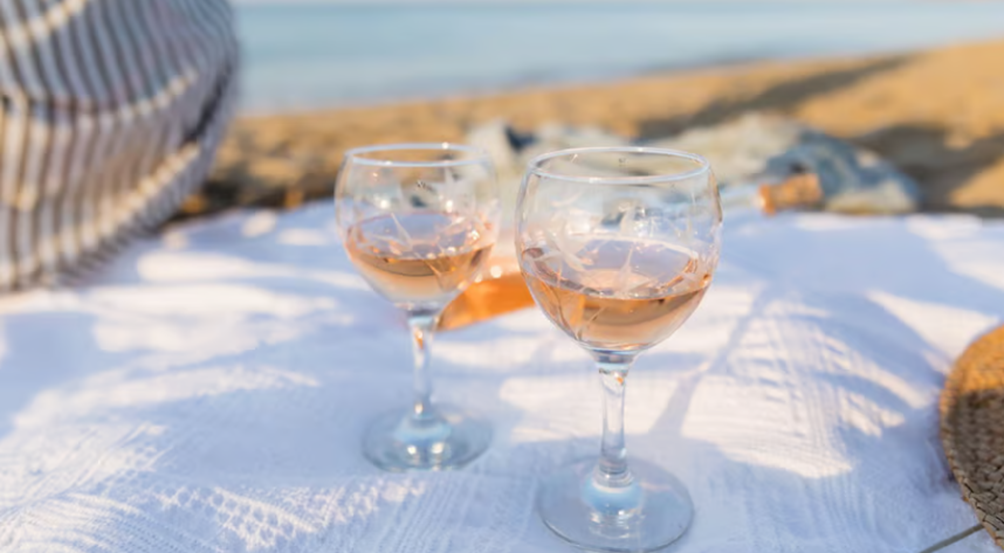
Culture | World in a dish | La
vie en roséHow Provençal rosé became the summer tipple par excellence
标题借用了一首法语歌的歌名La vie en rosé
( informal) ( especially BrE) an alcoholic drink ?par excellence /ˌpɑːrˈeksəlɑːns/( from French) ( only used after the noun it describes 仅用于所修饰的名词之后 ) better than all the others of the same kind; a very good example of sth 最好的;最优秀的;
When temperatures reach 26°C (78°F) in
Britain, a few things happen. People strip off(脱掉)their clothes and flock to parks
and swimming pools. And they buy rosé. According to Majestic, Britain’s largest
wine retailer, 26°C is the exact point at which sales of the pink stuff outpace those of red and white. During a heatwave last year, the company sold one
bottle every 12 seconds.?首段讲rosé在什么季节销量最好,并以英国最大的酒水零售商为例。Rosé is the ultimate summer tipple. Like a
strong, zesty margarita, a chilled glass of pale rosé makes a perfect aperitif.
(Unlike a margarita, you can probably enjoy more than two without disgracing
yourself.) People have been drinking versions of rosé wine for millennia,
starting with the ancient Greeks. More than 2,000 years ago the ancient Romans
started cultivating vineyards in Provence, in south-eastern France.Provence remains rosé’s heartland. With 35% of
the output, France is the world’s leading producer of rosé. It is also its
leading consumer: a third of the bottles of wine drunk there are pink in
colour. In the past 15 years, exports of Provençal rosé have increased by
around 500%. Château d’Esclans sells an eye- and mouth-watering 10m bottles
every year. LVMH, a luxury group that owns a number of revered champagne houses
and wineries has, in recent years, bought Château Galoupet and acquired stakes
in Château d’Esclans and Château Minuty, rosé juggernauts. In America,
Whispering Angel, a pink wine produced by Château d’Esclans, sells the most
bottles of any French wine of any hue.?先讲rosé的主产地、主要生产国与消费国,接着讲rosé在近十几年销量激增,LVMH奢侈品集团收购并入股几家行业巨头。最后讲一款叫Whispering Angel的rosé,在美国的销量居所有法国酒之首。a large and powerful force or institution that cannot be controlled 不可抗拒的强大力量;无法控制的强大机构→此处理解为行业巨头Travel and social media help explain the
wine’s global spread. Before the pandemic, France was the world’s leading
tourist destination. The pale wine came to be seen as sophisticated thanks to glitzy events such as the Cannes Film Festival(戛纳电影节). Social-media tributes like
#roséallday (a celebration of day drinking) and #brosé (a hashtag used by men
who enjoy the wine) have brought attention to the drink. Consumers have also realised the wine’s versatility, agreeing with Julia Child, a popular
television cook, that “rosé can be served with anything.” Dry
rosés, pleasantly acidic(酸的)and refreshing(提神的) (unlike the cloying(甜得发腻)notes rosé is infamous for, which are common in cheaper varieties), can accompany many cuisines well.?rosé在全球的流行,得益于(1)法国是热门旅游地(2)社交媒体的宣传。rosé并非每一款都受欢迎,比如很多便宜的rosé甜得发腻;备受推崇的是干性rosé,口味清新酸爽,与任何菜肴都可搭配。When the Kaufhaus des Westens (KaDeWe), a temple of consumption in West Berlin, celebrated its 115th birthday last month with a glitzy champagne party for 2,000, the mood was sparkling.→【外刊听力】Cutback Christmasin-这个前缀有“不,非,相反的”之意,但infamous并不是famous的反义,而是指“声名狼藉的”。
Rosé still remains a target of derision(嘲笑)among oenophiles. It has earned the offensive moniker(绰号)“bitch diesel” (so named
because it is pink and has been marketed to women). According to Sacha Lichine,
the president of Château d’Esclans, when he first approached
potential distributors he would get the door slammed in his face. Traditional
folk, “think that it’s not a real wine. They think that it’s a
Coca-Cola wine,” he explains.?前几段→rosé的销量与人气飙升,这一段→rosé仍遭受讥讽与冷遇。Barbara Drew, a master of wine at Berry
Bros & Rudd, Britain’s oldest wine merchant, suggests that the dismissal of rosé as “not a serious wine” is partly because it generally does not age as
well as red. So it's not of interest to some collectors and investors. But
such squabbles(争论)overvalue rosé’s central role in summer culture. Enjoying it is
nothing to blush at.?众所周知,葡萄酒年份越久越好,可rosé恰恰相反,越年轻的rosé口感越好。因此一些收藏家和投资者对rosé兴趣不大。

